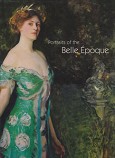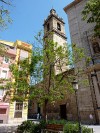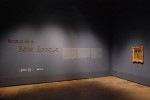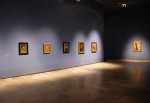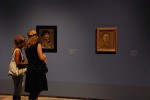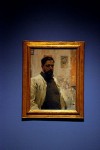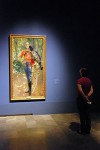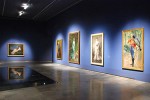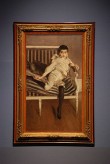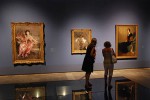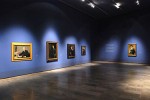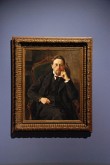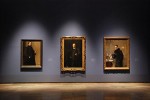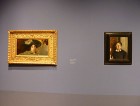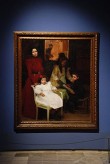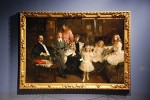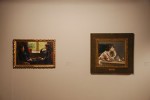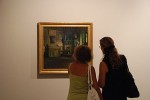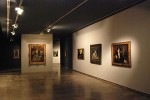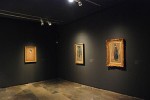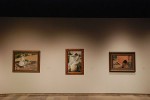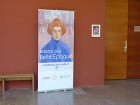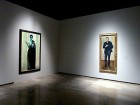The browser will either open the file, download it, or display a dialog.
Portraits of the Belle Epoque
Centro del Carmen, Valencia
April 5 – June 26, 2011
CaixaForum, Barcelona
July 19 – October 9, 2011
Curators: Tomàs Llorens and Boye Llorens
Catalogue
Portraits of the Belle Epoque.
Essays by Valeriano Bozal, Danièle Devynck, Barbara Guidi, Boye Llorens, Tomàs Llorens, and Pilar Pedraza; biographies by Alicia Izquierdo Ramírez.
Madrid: El Viso; Valencia: Generalitat Valenciana, Consorci de Museus de la Comunitat Valenciana; Barcelona: Fundación “la Caixa,” 2011.
272 pp.; 123 color illustrations, 4 b/w; bibliography.
ISBN: 978-84-95241-81-8 (English)
Retratos de la Belle Epoque
ISBN: 978-84-95241-79-5 (Spanish)
Retrats de la Belle Epoque
ISBN: 978-84-95241-80-1 (Catalan)
€55,89
The stunning exhibition Portraits of the Belle Epoque in 2011 resulted from the first collaboration between the Consortium of Museums of the Valencian Community and “la Caixa” Foundation in Barcelona. Tomàs Llorens, co-curator of the show with his son, Boye Llorens, deliberately included the commonplace phrase “Belle Epoque” in the title (fig. 1).[1] Rather than exploit the familiar, however, the exhibition aimed at using portraiture to restore a context for the crucial period from the end of the Franco-Prussian War to the end of World War I. In introductory remarks for the opening at the second venue in Barcelona, Llorens explained his desire to revise clichés about a period buried under a label so derogatory that historians hesitate to use it.[2] Belle Epoque, a tag invented in retrospect, has become so laden with nostalgia or irony that one of the organizers called it in his catalogue preface “an epitaph for an era.” Selecting nearly eighty portraits by some forty artists, the curators gave new life to the decades spanning the turn of the twentieth century, populating the walls with a vivid assembly of figures and countenances.
Three generations of artists made the works on display. The painters ranged in age from Giovanni Boldini, Marie Bracquemond, Hans Makart, and others born in the 1840s to Egon Schiele, the youngest and shortest lived, a victim of the Spanish flu epidemic in 1918. Changing styles and impulses from each succeeding literary and artistic ism were quietly pointed out in wall texts, but the show was neither conceived on stale evolutionary principles nor organized chronologically. Artists of various nationalities mingled and freely crossed borders between thematic sections. With some variations in hanging, the arrangement at the CaixaForum in Barcelona maintained the design of the first installation in Valencia, where the show opened in April 2011 at the Centro del Carmen, a cultural center in a restored convent in the heart of the old city (fig. 2).
Visitors in Valencia approached the exhibition area through a Gothic cloister, where a door led to the darkened gallery of the first section, “Self-Portraits” (fig. 3). An introductory panel described the period as a time of huge economic growth, far-reaching social changes, and great political turmoil. The popular genre of portraiture, the visitor was told, “mirrored modern man’s newfound individualism and his interest in the image he projects of himself within his social milieu.” The wall text stated the intent of the exhibition to show the transformation that took place during the period under scrutiny, “from the mood of euphoria and confidence of the early years – what would be remembered as the belle époque – to the crippling anxiety following in the wake of the Great War.”
Representing euphoria, one long wall of the initial gallery held a screen with continuous projection of scenes from Panorama of the Eiffel Tower, filmed at the Paris Exposition of 1900 by James H. White of the Edison Company Kinetograph department.[3] White’s elevator view was accompanied by a recording of piano pieces by Erik Satie from Sports et Divertissements(1914). On the opposite wall, Jean-Louis Forain’s self-portrait (1883) was the earliest in a row of six, including Eugène Carrière (c. 1890) and John Singer Sargent (1906), both lent by the Uffizi Gallery from the Vasari Corridor collection of artists’ self-portraits (figs. 4 and 5).[4] The self-portrait by Boldini in the exhibition was one of several preliminary attempts at filling the Uffizi’s request for his self-image; his final contribution was more finished, if less intense. In a pastel from the Oslo Museum that held its own among her colleagues’ oils, the Norwegian Asta Nørregaard depicted herself in 1889 at age thirty-six. Although one of her earliest pastels was a magnificent portrait of Edvard Munch (1885; Munch-museet), after 1890 she would distance herself from new tendencies in Norwegian art.[5] The Valencian painter Ignacio Pinazo Camerlench completed more than a dozen images of himself; the canvas on view resembles a work in the Prado, also from 1901, one of his two self-portraits in the Madrid museum.[6]
At the end of the first room, another great Valencian, Joaquín Sorolla, closed the group with a Self-Portrait (Museo Sorolla, Madrid) dated December 12, 1900 (fig. 6). During this signal year, Sorolla had won a Grand Prix at the Exposition Universelle in Paris for Sad Inheritance (1899; Bancaja, Valencia). That painting, more than nine feet long, shows a monk aiding handicapped children on the beach at El Cabanyal in Valencia; the children had been marked by the venereal diseases of their parents.[7] Despite its success, Sorolla turned toward less overt social comment after the turn of the century. The first image in the next section – “Society Portraits” – splendidly illustrates this change (fig. 7). Portrait of King Alfonso XIII Wearing the Uniform of the Hussars was painted during the summer of 1907 when Sorolla’s older daughter Maria completed her recovery from tuberculosis in the dry hills near Segovia. Almost as large as the royal image were those Sorolla made of his wife, Clotilde, and Maria enjoying the palace gardens in La Granja de San Ildefonso.[8] The king lent his portrait (along with that of the queen) to the painter’s major exhibition the following year at the Grafton Galleries in London, and again in February 1909 to the show in New York organized by Archer M. Huntington at The Hispanic Society of America. The international press recognized that with the sun-flecked Spanish king, Sorolla had struck a “new note” in court portraiture.
Next to the portrait of the king was that of his aunt, HRH the Infanta Eulalia of Spain (fig. 8). The Infanta posed for Boldini in 1898, but appears to have abandoned the project. The artist nevertheless displayed her portrait in 1900 at the Exposition Universelle and in two other previously undocumented exhibitions, as noted in the catalogue entry by Barbara Guidi; the picture remained unsold in the artist’s studio (96). Hanging next to the Infanta were Sargent’s Millicent, Duchess of Sutherland (1904), Sorolla’s Duke of Alba (1908), and Ignacio Zuloaga’s Comtesse Mathieu de Noailles (1913).[9]
In a stylish picture hung on the long wall facing the Spanish royals, a son of the Chilean diplomat Ramón Subercaseaux sits precariously on striped sofa cushions in Boldini’s Paris studio (fig. 9).[10] The same Boldini divan appeared in dozens of his portraits, and he sometimes reupholstered it from his palette to match the sitters’ apparel. It was still in his studio in 1916, when another member of the prominent Chilean clan, Olivia de Subercaseaux Concha, alighted there to achieve immortality as The Woman in Pink (fig. 10).[11] Pedro Subercaseaux – he would have been about eleven in 1891 when the boy on the striped cushions was painted – notes in his memoirs that Boldini made another portrait of him at age seven standing next to his younger brother Luis; he does not recall, however, posing on the divan; both his portrait and that of his exuberant kinswoman in pink remained in the artist’s possession (104–7). Boldini’s next work in this group of three was a sinuous half-length Portrait of Cléo de Mérode (1901; private collection) commissioned by the wealthy collector Sigismond Bardac, an admirer of both the celebrity ballerina and the painter.[12] The exhibition offered viewers an alternative likeness of the idolized Belle Epoque beauty: Manuel Benedito, another Valencian, portrayed a sober Cléo de Mérode (1910; Santander Collection), draped in a reversible stole of sable and ermine.
Moving from the glittering royal costumes and the colorful shoes of high society, the visitor encountered a room with fourteen single portraits – none extending much below the knees – lining the walls of the third section: “Temperament and Character” (fig. 11). There were, inevitably, rich and famous men. There were women, as well, and one of them was also rich: Yevdokia Morozova, a former café singer in Moscow. In 1908, the year after she married Ivan Morozov, the renowned art collector commissioned her portrait from Valentin Alexandrovich Serov. After the revolution, the couple had to move into three rooms of their confiscated mansion until they could emigrate in 1919. The Morozova portrait was one of two Serov paintings in the exhibition; the second was among the artist’s last works, Portrait of Vladimir Girshman (1911). Serov portrayed the Moscow collector in his office, reaching for his vest-pocket watch in what his wife called a characteristic gesture. Serov had completed an intimate portrait of Henriette Girshman in 1907, capturing his own reflection in her boudoir mirror. The Serovs are among five works in the exhibition lent by the State Tretyakov Gallery, including a Portrait of Anton Chekhov commissioned in 1898 from Osip Braz by Pavel Tretyakov himself (fig. 12). Another of the five eminent authors in this gallery was Leonid Andreyev by Ilya Repin (1904; State Tretyakov Gallery), a brilliant depiction of his young friend and neighbor.
A third writer stood enjoying his customary cigar in the smoking section at the end of the room (fig. 13). Sorolla painted his close friend Vicente Blasco Ibañez in 1906, the year the Valencian author published what was recognized at once as a key novel, La Maja desnuda, later translated as Woman Triumphant (1920). The painter hero was widely believed to represent Sorolla, which the author denied in the preface to the English translation; the novel was in fact autobiographical.[13] The cigar smoker in the middle of the three standing portraits was the London art dealer Asher Wertheimer. He began commissioning family portraits from Sargent in 1897–98; in compliance with his wishes, his widow and children presented ten of them to the Tate in London after his death. For this picture and for Sargent’s group portrait of three Wertheimer children in the next room, Elaine Kilmurray and Richard Ormond contributed excellent catalogue entries, pointing out the latent anti-Semitism and condescension in critical responses to both pictures (120–2, 150–1). The third smoker was the elegant Norwegian artist Gerhard Munthe (1885; The National Museum, The National Gallery, Oslo) depicted by Christian Krogh as Munthe made his way through the ambient smoke in the Grand Café in Christiania (Oslo).
On the adjacent wall hung a painting from 1897 lent by the Association des Amis du Petit Palais, Geneva, tentatively identified as Marcel Proust and attributed to Jacques-Emile Blanche. In his catalogue entry Tomàs Llorens compares it to the earlier Proust portrait by Blanche in the Musée d’Orsay; the curator is not certain that the painting in Geneva represents the French novelist, but supports an attribution to Blanche (134–5). The portrait of the fifth author, Vernon Lee (the pseudonym of Violet Paget), was the smallest picture in the room (fig. 14). She was small herself and sparkled with so much temperament and character that even her friends sometimes found her conversation strenuous. She and Sargent had shared an expatriate childhood, and he painted the sketch in a single, brief session in June 1881, when they were both in London. With his brush, he scratched a dedication “to my friend Violet / John S. Sargent” into the paint above her head and retrieved the lively little portrait to exhibit in Paris the following year.[14]
Following this unlikely salon gathering – an oddly muted tertulia of powerful temperaments – the fourth section introduced a dramatic change of scale. The five paintings selected for “Group Portraits” brought together Sorolla's two most important works in that category. For The Family (1901) Sorolla depended on a photograph by his father-in-law, then moved himself to the background using a Velásquez strategy: the self-portrait in a mirror (fig. 15). With the commission in 1905 to portray The Family of Rafael Errázuriz Urmeneta, Sorolla could again put to good use his rapt study of Las Meninas at the Prado: he painted both the Chilean family and his own in Madrid (fig.16).[15] In distant Chicago in 1911, Sorolla completed the group entitled Mrs. Ira Nelson Morris and her Children (The Hispanic Society of America, New York), with its strong flavor of Sargent (fig. 17).[16] Next to Mrs. Morris, as if to demonstrate this influence, hung a masterpiece by Sargent himself in which three Wertheimer children are matched with three pet dogs. The black standard poodle Noble, whose lolling pink tongue gave a bit of color to Asher Wertheimer’s single portrait, has settled in front of a white ottoman to command full attention; Sargent silhouetted the dog’s black taffeta bow against Ruby Wertheimer’s scarlet frock.[17] The fifth group portrait was Sorolla’s The Drunkard, Zarauz (1910; private collection), painted in a tavern on the Basque coast, probably on a day too wet to work outdoors.
To view the fifth section in Valencia, exhibition goers had to return to the cloister and mount a baroque stairway. Entitled “Moods and Conversations,” the first gallery upstairs included ten paintings, most of them depicting single figures in a state of reverie or repose, rendering conversation impossible. Moods were foremost in Erik Werenskiold’s Memories, a double portrait of his wife and sister-in-law, seated at a window in listless self-absorption (fig. 18). To the right of the Werenskiold hung an intriguing pastel and one that fit perfectly in this section: Dans le Bleu by Amélie Beaury-Saurel. In his entry on this work, Gabriel P. Weisberg points out that the career of Beaury-Saurel, who had begun classes at the Académie Julian in 1878, was well established by the time she dated the pastel in 1894 (164). Early the following year she married Rodolphe Julian and ran the school after his death in 1907.[18] A well-known setting for conversation was the subject of Sargent’s An Interior in Venice, painted in the summer of 1898. It shows two couples at tea in the Baroque salone of the apartment in the Palazzo Barbaro on the Grand Canal where the parents of his friend Ralph Wormeley Curtis had lived for more than a decade. After Curtis’s mother, disappointed in her own likeness, rejected the gift of the little picture, Sargent deposited it at the Royal Academy as his diploma work in 1899.[19] Another diploma work shown in this section was deposited a decade later: Black and Silver by James Jebusa Shannon. The picture functions both as a portrait of Shannon’s daughter Kitty and as a Whistlerian exercise in color harmonies, as MaryAnne Stevens points out in her catalogue entry (168). Welcome inclusions in this group of pictures – although difficult to characterize as either mood or conversation – were Peder Krøyer’s intimate double portrait, painted late in 1898, of the Norwegian composer Edvard Grieg accompanying his wife, Nina, and Maurice Lobre’s enchanting interior called The Bathroom of Jacques-Emile Blanche, well received at the Salon of 1889 (fig. 19).
The section ended appropriately with a seated portrait of Misia Godebska, another celebrity muse of the Belle Epoque, painted by Pierre Bonnard (fig. 20). Behind Misia was an almost parenthetical monographic section with four works by Toulouse-Lautrec, and beyond that, one last “Moods and Conversations” picture by Santiago Rusiñol. The placement of Rusiñol’s Grand Bal after the Toulouse-Lautrec portraits is justified by its setting, a passage leading into the Moulin de la Galette. The section on Toulouse-Lautrec felt meager, but the catalogue essay by Danièle Devynck places his innovative standing male portrait series from 1888 to 1891 at the core of the artist’s synthesis of observation and psychological analysis (fig. 21).[20]
A bright array of a dozen “Plein-air Portraits” – the seventh section – began with an interesting choice. Old enough to have studied under J.-A.-D. Ingres, Marie Bracquemond lived through the transformation documented in the show, although she stopped painting before the turn of the century. She painted On the Terrace at Sèvres (1880; Association des Amis du Petit Palais, Geneva) at her home, the Villa Branca. A few years earlier Félix Bracquemond had shown the old Sèvres porcelain manufactory in the background of his etching of his wife painting her sister. Gilles Genty supplied exceptionally helpful entries on this work, as well as on others by Maximilien Luce and on the pair of portraits by Gustave Caillebotte of Père Magloire Raulin, a much-esteemed gardener in Etretat on the Normandy coast (fig. 22). The last three Sorolla works in the show were aligned in a spectacular row: Clotilde, his wife, between her daughters Elena and Maria (fig. 23). The room ended with a painting in harsh contrast to the gardens or the beaches that precede it: The Evening Return Home by Théophile-Alexandre Steinlen (fig. 24). The frontal close-up of a working woman encountered at dusk on a city street is a face for the brave new century.
Entering the eighth section, “The Portrait as Symbol,” viewers were drawn to a powerful corner shared by Hermen Anglada-Camarasa and Edvard Munch (fig. 25). Almost nothing is known about the French-Swiss litterateur Marcel Archinard, Munch’s subject for his impressive portrait.[21] One of the earliest in a series of full-length, standing male portraits Munch produced in the first decade of the twentieth century, the picture was first exhibited in the late summer of 1904 in Copenhagen and appeared in nearly a dozen shows before it was acquired in Christiania for the National Gallery in 1909.[22] The focus of attention on the main wall of the symbolist portrait section was what the Viennese call “a beautiful corpse,” represented in a small, square portrait by Gustav Klimt (fig. 26). Maria (Ria) Munk, at age twenty-four, shot herself in the heart in 1911. Her wealthy parents, Alexander and Aranka Pulitzer Munk, commissioned Gustav Klimt to paint a deathbed portrait from a photograph, then, some years later, two standing portraits.[23] A letter breaking off their engagement from the popular German writer Hanns Heinz Ewers had prompted the young woman’s suicide. Ewers published the bestseller Alraune (Mandrake) in1911; a character in his tale of a bloodthirsty gynoid (female android) was the perverse daughter of a Jewish industrialist.[24] Next to the Ria Munk portrait was Henryka Cohn, painted by Richard Gerstl just before the discovery of his affair with Arnold Schönberg’s wife led to his despair and suicide.
The last works in this gallery, all three in gray and brown tones, led off the ninth and final section of the show: “Crisis” (fig. 27). The Vienna-born actress Tilla Durieux was painted by Max Oppenheimer in 1912, two years after her marriage to Paul Cassirer, an eminent art dealer in Berlin (fig. 27).[25] Her hands are as skeletal and expressive as if they were painted by Egon Schiele, whose self-portrait The Poet is one of only four works in the last room (fig. 28).[26] The closing bracket to the exhibition that opened with a filmed elevator ride up the Eiffel tower was a large-screen projection of archival footage from the front in World War I.[27] Bitterness, despondency, desolation, solitude: words in the wall texts pointing to a view of life in the last decades of the period felt inadequate in the face of the annihilation of those futile battles. Many a viewer returned to earlier galleries – Clotilde Sorolla after a swim, Blasco Ibañez before he was forced into exile, the bright little Wertheimer boy before he felt obliged to change his name to Conway – for a sunnier view of the Belle Epoque to raise their spirits.
The acceleration and shock of the last rooms were intentional. Throughout the show, the curators’ wide-ranging selections brought surprises and, for the most part, fed a visual narrative that enabled insights into both the confidence and the fragility of the sitters. The catalogue can be praised without reservation for its entries on the paintings, illustrated with excellent color reproductions and written by twenty-five specialists. The essays, however, each captivating to read, lose value in a book that is not indexed. A library scan of the table of contents would not reveal, for example, that Valeriano Bozal’s “The Moral Comfort of the Subject” is a brilliant essay on money and wealth in Edith Wharton, Thomas Mann, and Henry James. Barbara Guidi usefully studies “Commercial Portrait Artists” and the market strategies of the key players. Pilar Pedraza soars over the material – from Rosa Bonheur to Marcel Duchamp as Rrose Sélavy – in her delightful “Women Between Two Worlds.” She stops to praise Sorolla’s Maria with Hat for “a human face, interesting, alive and with a gaze that bears no relation to the siren songs of the sensual doll” (43). On woman as sensual doll, Pedraza discusses Auguste de Villiers de l’Isle Adam, whose novel The Future Eve (1886) features an android (andréide) – Hadaly, the ideal woman – invented by Thomas Edison. Boyes Llorens offers “Dandyism in the Belle Epoque,” a relevant study of Oscar Wilde, James Whistler, and others; it is particularly valuable for its reproduction of Sargent’s Doctor Pozzi at Home (1881; Hammer Museum, Los Angeles), unavailable for the show. As mentioned earlier, Danièle Devynck contributes a fine survey of Toulouse-Lautrec as portrait painter, and the last essay is by Tomàs Llorens, “Between Sleep and Wakefulness.” Llorens reflects on Marcel Proust and identifies as the defining feature of the period “a new, urgent romanticism that seems to drive its subjects fatally to psychic instability” (73).
This ambitious show sought, and made visible, poetic affinities. It drew energy from friendships of the artists with their sitters and amongst themselves: Sorolla with Anders Zorn, Krøyer, and Sargent, for example, or Ramón Casas with Rusiñol. The elder Llorens has labored in the past to correct the effects of a once-dominant “historiographical model reducing the history of art to a succession of 'movements’ or 'isms’ that are characterized by supposed formal innovations.”[28]Portraits of the Belle Epoque allowed the visitor to see artists co-existing across national boundaries, pursuing their work, and adapting to trends as they saw fit. This approach provided a gently mediated look at a sample of faces from a period Eric Hobsbawm has called the age of empire. Setting off the core group of Sorolla, Sargent, and Boldini works were singleton appearances – Zorn, Krohg, Krøyer, Werenskold, and Munch, to name only the Scandinavians – tokens of a huge and varied production of painters at their easels in what could certainly be described as a golden age of portraits. One can only be grateful for a chance to gaze at Chekhov or a handsome fellow who might (or might not) be Marcel Proust, or even to admire the fashion parade on Boldini’s chameleon-like divan.
It was exactly one century ago – 1912 – that Klimt painted the face of the late Ria Munk, and Oppenheimer the wintry form of Tilla Durieux, her costume breaking into Cubist folds. The trajectory of these two portraits over the years that brought them to Valencia and Barcelona is moving in itself, and the survival of many others seems miraculous.[29] An exhibition of this scope can no longer be taken for granted. Thanks are due the forty-two painters of the Belle Epoque and their sitters for the works in this opulent show, the patrons who commissioned them, the collectors who acquired and preserved them, the many scholars who have described them so well, the publishers El Viso for a catalogue that does the paintings justice, the sponsors for their generosity in another time of crisis, the staff at the two venues who installed them so beautifully, and, chiefly, the curators for their wise and equitable choices. They have assembled a convincing look at to what extent a genre of painting can preserve an era.
Jane Van Nimmen
Independent scholar, Vienna, Austria
vannimmen[at]aon.at
[1] Tomàs Llorens was chief curator at the Museo Thyssen-Bornemisza, Madrid, from 1992 until 2005 and was involved until recently with the development of the Museo Carmen Thyssen Málaga.
[2] Llorens is quoted in Roberta Bosco, “Los rostros de la 'Belle Epoque’ en CaixaFòrum,”El País, July 20, 2011.
[3] A wall label credited Unseen Cinema: 1. The Mechanized Eye: Experiments in Technique and Form, a DVD series of 2005.
[4] Carrière painted himself repeatedly (examples are in the Metropolitan Museum of Art in New York and the Musée d’Orsay, Paris) but neglected to fulfill the Uffizi’s request in 1895 for a self-portrait (84). He apparently gave the picture in this show to the art historian Woldemar von Seidlitz, who served as general director of the royal art collections in Dresden from 1885 until 1918; the Uffizi acquired it from the von Seidlitz heirs in 1961. Sargent, by contrast, delivered his picture within six months of the request, painting it quickly outdoors in the Val d’Aosta (88).
[5] See Anne Wichstrøm, “Gendered Representation: Asta Nørregaard’s Upper-class Portraiture, 1890–1905,” Konsthistorisk Tidskrift 69 (2000), 19–32. In 1890 Nørregaard painted a half-length self-portrait in summer clothing; that large oil painting is also in the Oslo Museum.
[6] Pinazo’s Prado self-portrait of 1901, as well as another from the Casa Museo Pinazo, Godella, are illustrated in the superb catalogue by William Hauptman, El Modernismo de Sorolla à Picasso, 1880–1918 (Lausanne: Fondation de l’Hermitage / 5 Continents Editions, 2011), 56–57.
[7] The coal magnate John E. Berwind bought Sad Inheritance and installed it in the Sunday school room of the Church of the Ascension in New York City; he lent it in 1909 to the Sorolla exhibition at The Hispanic Society of America. For Robert Rosenblum’s essay on his discovery of the picture in the 1970s and his sorrow when it was sold in 1981 to the bank, see “Sargent/Sorolla: Reversals of Fortune,” in Sargent/Sorolla, exh. cat. (Madrid: Turner / Fundación Colleción Thyssen-Bornemisza, 2006). Tomàs Llorens was curator of this alluring exhibition, also seen at the Petit Palais, Musée des Beaux-Arts de la Ville de Paris.
[8] The artist’s appointment at the king’s summer residence at La Granja is documented in photographs preserved in the Museo Sorolla in Madrid. The movie director José Antonio Escrivá used the photos to reconstruct the scene in Cartas de Sorolla (Letters of Sorolla), a fascinating biopic filmed for Spanish television in 2005. The catalogue entry on this portrait by Blanca Pons-Sorolla, the granddaughter of Maria Sorolla, is particularly rich in information (94–5).
[9] Selected for the exhibition catalogue cover as an archetype of the Belle Epoque, Sargent’s portrait of the duchess sold in New York in 1979 with the Benjamin Sonnenberg Collection and was acquired in 1983 by the Museo Thyssen-Bornemisza, Madrid. The Duke of Alba’s portrait remains in the family collection. The portrait of Countess de Noailles was purchased in 1919 by the shipping tycoon Ramón de la Sota and given to the Bilbao Museum. Zuloaga worked simultaneously in 1913 on his portrait of her friend Maurice Barrès, and Jacques-Emile Blanche painted her that year as well. The countess, an accomplished nature poet admired by Marcel Proust, had published her first collection (Le Coeur innombrable) in 1901.
[10] Boldini had taken over Sargent’s studio at 41 boulevard Berthier in 1886. The divan cushions were not striped in the Portrait of Miss Errázuriz (1892; private collection), the large, saucy portrait famous for its inch of bare thigh. The artist first exhibited the girl’s picture (as well as a portrait of Mme. E.) in 1892 in the Champ-de-Mars Salon (Société Nationale des Beaux-Arts), then sold both paintings to Baron Maurice de Rothschild. The child and her eclectic outfit – reminiscent of kiddie pageant costumes on the American television series “Toddlers and Tiaras” – continue to charm; the portrait broke auction records for Boldini in November 2010 when Sotheby’s sold it for some $6.5 million.
[11] Olivia was a niece of Emiliana Concha Subercaseaux, whose portrait – known as the “White Pastel” (Pinacoteca di Brera, Milan) – had earned Boldini an award at the Exposition Universelle in 1889. The painter kept the pastel and sold a replica to the sitter. Olivia’s grandfather, Melchor Concha y Toro, had purchased an estate at Pirque south of Santiago in 1883; there he would develop one of the renowned Chilean wineries.
[12] For a recent study of the Mérode cult, see Michael Garval, “Cléo de Mérode’s Postcard Stardom” in this journal (Spring 2008), and Christian Corvisier, Cléo de Mérode et la photographie: La première icône moderne (Paris: Editions du Patrimoine, 2007). A blog posting reproduces her two images in the Portraits of the Belle Epoque exhibition and includes those taken by Cecil Beaton of Cléo de Mérode in her nineties.
[13] Blasco wrote of his artist-hero, Mariano Renovales, in Triumphant Woman: “Renovales forgot his distinction as an innovator in order to win at any cost fame as a portrait painter of society people. He painted members of the royal family in all sorts of postures, not omitting any of their important occupations.” The Galician feminist author Emilia Pardo Bazán also wrote a novel about an artist tempted to sell out and become a society portraitist: La Quimera (1905). Sorolla had painted Elena Ortuzar de Elguin (1905; Museo de Bellas Artes, Santiago de Chile), the married Chilean society woman who became Blasco’s mistress and, in 1925, his second wife.
[14] The appearance of the sketch ( Sargent called it a pochade) at the first exhibition of the Société internationale des peintres et sculpteurs at Galerie Georges Petit in 1882 was apparently the last time Vernon Lee was on display until the posthumous exhibition in 1926 at the Royal Academy, London. A drawing of Lee from 1889 is in the Ashmolean Museum, Oxford.
[15] Rafael Errázuriz Urmeneta was the youngest of four children of the Chilean winegrower Maximiano Errázuriz. Rafael Errázuriz and his wife Elvira Valdés Ortuzar were in Rome in 1905, and Sorolla insisted they come to Madrid with their six children for the sittings. In only twelve days, Sorolla painted their portrait in his studio on the Calle Miguel Angel, where he lived from 1904 until1911. Errázuriz served as Ambassador of Chile to the Holy See from 1907 until 1921. He died in Rome on December 26, 1923; Sorolla died on August 10 that year in Cercedilla, near Madrid. The vineyards founded by Maximiano Errázuriz, Rafael’s father, still produce some of the leading Chilean wines.
[16] In his entry on the Morris picture and its subjects, Marcus Burke of The Hispanic Society of America cites several critics who have commented on its closeness to Sargent, including Javier Barón in Sargent/Sorolla (2006), as in n. 7 above.
[17] For illustrations of the other family portraits, see Norman Kleeblatt, ed., John Singer Sargent: Portraits of the Wertheimer Family, exh. cat. (New York: The Jewish Museum, 1999).
[18] Weisberg underlines Beaury-Saurel’s role in training women as art professionals. See also Gabriel P. Weisberg and Jane R. Becker, Overcoming All Obstacles: The Women of the Académie Julian, exh. cat. (New York: Dahesh Museum, 1999).The woman in the pastel by Beaury-Saurel remains unidentified, but Weisberg does not exclude the possibility that it is a self-portrait. In a video interview at the time of the opening of Portraits of the Belle Epoque in Barcelona, the co-curator of the show Tomàs Llorens chose to stand directly in front of Beaury-Saurel’s pastel, allowing the viewer a good long look at this unusual work.
[19]An Interior in Venice was one of a handful of works scheduled to be exhibited only in Valencia. The informative entry by Elaine Kilmurray and Richard Ormond on this “conversation piece” suggests that there was more conversation about the picture than in it.
[20] Two from the series were displayed in Valencia – François Gauzi and Gaston Bonnefoy – and Paul Sescau was added to the show in Barcelona. The portraits from the Musée Toulouse-Lautrec in Albi of the actor Cadieux and the prostitute Marcelle on view in Valencia were replaced in Barcelona by the drawing Chocolat dansant, also from Albi.
[21] Archinard was probably living in Berlin in 1904. He wrote a tribute to Adolph von Menzel when the German artist died in February 1905; see “Variétés,” Mercure de France (March 15, 1905), 308–11. Closest to the Archinard painting in scale and background is Munch’s Portrait of Miss Warburg(1905; Kunsthaus, Zurich). The Hamburg banker Albert Warburg and his wife, Gerta, commissioned Munch to paint a wedding portrait of their daughter Helene Julie (Ellen), before her marriage to Edgar Burchard. Ellen Burchard was deported from Hamburg in 1942 and murdered in Auschwitz; her mother fled with her sister Betty to Holland, but they were deported from Westerbork in 1943 and were presumably gassed in Sobibor.
[22] On the purchase, see Jan Kneher, Edvard Munch in seinen Ausstellungen zwischen 1892 und 1912 (Worms: Wernersche Verlagsgesellschaft, 1994), 286 and n.91, 488.
[23] All three Klimt pictures of Ria Munk were exhibited in Vienna 1900: Klimt, Schiele and Their Times, ed. Barbara Steffen on behalf of the Fondation Beyeler, exh. cat. (Ostfildern: Hatje Cantz, 2010). In Valencia, Portrait of Ria Munk I had by late June 2011 been replaced with a reproduction and was not scheduled to be shown in Barcelona; the painting was owned by Barbra Streisand from 1969 until 1999 and is now in a private collection.
[24] Marian Bisanz-Prakken detected a mandrake in the upper right of Klimt’s unfinished Ria Munk III (1917–18), the portrait seized by the Nazis in 1941, when Ria’s mother was deported to the Litzmannstadt (Łódź) ghetto, where she died in November of that year. In 2009 the portrait was restituted to the heirs of Aranka Munk and auctioned at Christie’s in 2010. Bisanz-Prakken’s article is available online, with illustrations in a PDF version (from Parnass 3/2009).
[25] Durieux was painted by a number of artists, including Franz von Stuck, who depicted her in the title role of Calderón’s comedy Circe (1913) and by the elderly Auguste Renoir. “The Stage” Year Book (1912) called her “the best-known 'modern’ actress of Berlin.”
[26] Undeniably symbolist, Mikhail Vrubel’s Pan appeared to have been displayed with the “Crisis” group because of its tonality. The catalogue entry by Natalia Ardashnikova mentions that the canvas began as a portrait of the artist’s wife; Vrubel then scratched it out to paint the figure of Pan after reading Anatole France’s “Saint Satyre” in Le Puits de sainte Claire (1895). This does not explain the puzzling installation of the nature god between the urban portraits of Oppenheimer and Kokoschka.
[27] The footage was part of a documentary by Laurent Véray and Agnès de Sacy, Le héroïque cinématographe (2003). The accompanying music in the gallery was a passage from “The dance round the golden calf” from Act II of Schoenberg’s unfinished opera Moses und Aron, a work inspired by the incident in 1921 when the composer was driven out of Mattsee, a summer resort near Salzburg, by an anti-Semitic campaign.
[28] Tomàs Llorens, “Foreword” in Blanca Pons-Sorolla, Joaquin Sorolla, ed. Edmund Peel, trans. Everett Rice (London: Philip Wilson, 2005), 7.
[29] Even more astounding is that Tilla Durieux lived until 1971, surviving both the world wars and serving in the Yugoslav resistance after the Nazis arrested her third husband, Ludwig Katzenellenbogen, and deported him to Oranienburg; he died there in 1944. Durieux, however, was not the longest surviving subject of a portrait in the show: Ira Victor Morris, depicted by Sorolla in 1911 with his mother and sister, died in 1972; a writer and an activist for nuclear disarmament, Morris was the father of the renowned Japanologist Ivan Morris.


